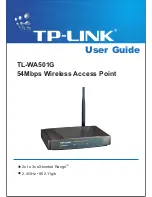
88
Appendix B
About Wireless LANs
This Appendix provides some background information about using Wireless LANs (WLANs).
Modes
Wireless LANs can work in either of two (2) modes:
•
Ad-hoc
•
Infrastructure
Ad-hoc Mode
Ad-hoc mode does not require an Access Point or a wired (Ethernet) LAN. Wireless Clients (e.g. notebook
PCs with wireless cards) communicate directly with each other.
Infrastructure Mode
In Infrastructure Mode, one or more Access Points are used to connect Wireless Clients (e.g. Notebook PCs
with wireless cards) to a wired (Ethernet) LAN. The Wireless Clients can then access all LAN resources.
Access Points can only function in "Infrastructure" mode,
and can communicate only with Wireless Clients which are
set to "Infrastructure" mode.
BSS/ESS
BSS
A group of Wireless Clients and a single Access Point, all using the same ID (SSID), form a Basic Service Set
(BSS).
Using the same SSID is essential
. Devices with different SSIDs are unable to communicate with each other.
ESS
A group of Wireless Clients, and multiple Access Points, all using the same ID (ESSID), form an Extended
Service Set (ESS).
Different Access Points within an ESS can use different Channels. In fact, to reduce interference, it is recom-
mended that adjacent Access Points SHOULD use different channels.
As Wireless Clients are physically moved through the area covered by an ESS, they will automatically change to
the Access Point which has the least interference or best performance. This capability is called
Roaming
. (Ac-
cess Points do not have or require Roaming capabilities.)
Channels
The Wireless Channel sets the radio frequency used for communication.
B
Summary of Contents for WRT-413
Page 1: ...i 802 11g Wireless Broadband Router WRT 413 User s Manual...
Page 6: ......
Page 33: ...27 Figure 19 Windows NT4 0 DNS...




































